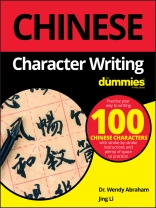Learn to write 100 characters in Chinese
Billions of people worldwide speak Chinese—and now you can learn to write 100 characters in the world’s most-spoken language! Whether you’re taking a course, looking to get ahead at work, or just want to up the ante when you’re communicating with Chinese-speaking family and friends, Chinese Character Writing For Dummies gets you up to speed fast.
This workbook will guide your first steps in learning Chinese characters. It contains 100 basic characters, including 44 simple characters (pictograms and symbols) and 56 composite characters (ideograms and ideo-phonograms). It helps you little by little to familiarize yourself with the pieces of the puzzle most frequently used, as well as some basic Chinese writing rules.
- Offers online bonus content that includes instructional videos, downloadable flashcards, and printable writing pages
- Shows you how to write 100 Chinese characters
- Provides instruction for beginners, students, and lifelong learners
- Gives you helpful tips on how to memorize characters
Chinese Character Writing For Dummies can help you today!
Cuprins
Introduction 1
About This Book 1
Foolish Assumptions 2
Icons Used in This Book 2
Where to Go from Here 2
Chapter 1: Wrapping Your Mind around the Chinese Writing System 3
Appreciating the Complexities of Written Chinese 3
How the Written Word Unifies China 4
What? No Alphabet? 5
Which Way Did They Go? The Direction of Characters 5
Chinese Language Reform 6
Traditional versus Simplified Characters 7
Why Learn to Write Chinese? 8
Strategies for Learning to Write Chinese Characters 8
Set goals 9
Write, review, rinse, repeat 9
Cultivate your inner character whisperer 10
Practice creative visualization 10
Chapter 2: Understanding the Structure of Chinese Characters 11
Simple versus Composite Characters 11
The Six Scripts 12
Pictographs 13
Simple ideographs 14
Compound ideographs 14
Phonetic compounds 14
Reciprocal characters 15
Phonetic loan characters 15
What a Radical Idea! The Incredible Radical 15
Why all the fuss about radicals? 16
How to use a Chinese dictionary without an alphabet 16
Deciphering Strokes 17
Types of strokes 18
Stroke order 19
Chapter 3: Preparing to Write Beautifully 21
From Then to Now: A Brief History of Chinese Writing 22
Carving on bone 22
From etchings to brush and ink 22
Adding bronze carvings to the mix 23
Widespread use of brush and ink 23
Moveable type and word processing 23
The Evolution of Chinese Script 24
Oracle bone script 24
Bronze inscriptions 25
Seal script 25
Clerical script 26
Running script 26
Grass script 26
Regular script 27
The Four Treasures of Chinese Calligraphy 27
Writing brush 28
Ink 29
Rice paper 29
Ink stone 29
Tools and Techniques for the Modern-Day Calligrapher (or Writer) 30
Chapter 4: 100 Chinese Characters 33
Appendix A: The 214 Chinese Radicals 83
Appendix B: Compound Words to Practice 91
Appendix C: Sentences to Practice 101
Appendix D: Blank Grids for Extra Practice 113
Despre autor
Dr. Wendy Abraham is an award-winning public speaker who has taught Chinese language, literature, and culture at universities throughout the U.S. She holds a doctorate from Columbia University, and pursued a Ph D in Chinese literature at Stanford University.
Jing Li is a language teacher and researcher at the National Institute for Oriental Languages and Civilizations (INALCO) in Paris.












